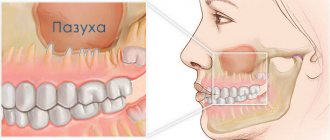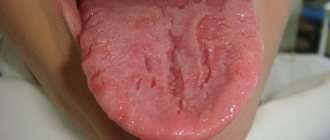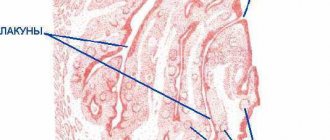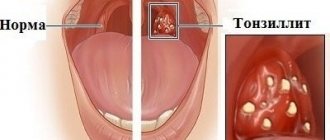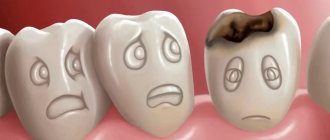Acute sinusitis is an inflammatory process that occurs in the mucous membrane of the nasal appendages (sinuses), so sometimes the diagnosis of sinusitis is also related to inflammation. This disease is characterized by swelling of the cheeks and purulent discharge, accompanied by an unpleasant odor.
In terms of its symptoms at the onset of the disease, the acute form of sinusitis is very similar to a common runny nose, only the treatment of the disease can be more difficult and lengthy. And the condition itself causes enormous discomfort to the patient and interferes with a full life.
Anatomy of the sinuses
There are 4 types of sinuses in the human skull:
- frontal (in the forehead area);
- maxillary, also known as maxillary (in the area of the cheeks under the eyes);
- ethmoid sinuses, or cells of the ethmoid labyrinth (in the area between the nose and eye);
- wedge-shaped (in the very middle of the skull, behind the eyeballs).
The sinuses are peculiar voids that reduce the weight of the skull, participate in the formation and sonority of the voice, in the process of smell, and also serve as shock absorbers for injuries to the facial skeleton.
They also perform a protective function: when foreign particles and bacteria enter the nasal cavity, the nasal mucosa is irritated, sneezing begins, and the particles are evacuated from the body along with mucus. But if the body’s defenses are weakened, bacteria can enter the sinuses from the nasal passages and cause severe inflammation, which is what we observe during the development of acute manifestations of the disease.
Why is this complication dangerous?
The maxillary sinuses located above our upper jaw (their area extends from the inner corner of the eye to the outer) perform important functions. They can warm the air and thereby protect the respiratory tract from hypothermia and foreign particles. The sinuses are located under the bone tissue and if its thickness is too small, when cleaning the dental canals, filling masses can fall into these cavities. Once the filling is completed, it is no longer possible to remove the foreign material on your own, since this procedure can only be carried out by a specialized specialist who has the necessary tools. The doctor can perform this procedure without difficulty and it will not take much time. It is numbed with local anesthesia and after removing the foreign body from the maxillary sinus, the patient will need to stay in the clinic for several hours. In some cases, discharge occurs the day after this minimally invasive procedure.
Why do the maxillary sinuses become inflamed more often?
Among inflammations of the paranasal sinuses, acute sinusitis - inflammation of the maxillary sinuses - is most often diagnosed. And there are several reasons for this:
- the maxillary sinuses are the largest in volume;
- The maxillary sinuses are connected to the nasal cavity using anastomoses - small openings covered with mucous membrane (these openings are quite narrow, and even a slight swelling of the mucous membrane with minor inflammation can make it difficult for mucus to come out of them, and the formed and accumulated mucus in the absence of proper outflow becomes a powerful catalyst, if the inflammatory process develops first in neighboring ones.).
Prevention is the best remedy for sinus inflammation
Of course, no one can be 100% insured against sinusitis and more severe inflammatory processes. Prevention will help strengthen the immune system and build a protective barrier against viruses, bacteria and infections. To prevent sinusitis without symptoms in an adult or child, you should follow simple rules:
- Avoid hypothermia. Yes, low temperature in itself does not provoke colds and runny nose. But it causes a narrowing of blood vessels and makes the mucous membranes more vulnerable to viruses and infections. In cold, rainy and windy weather, it is important to properly insulate - and you will not face chronic inflammation of the sinuses.
- Rinse your nose more often. This should be done in the fall during epidemics of colds and flu, as well as in the spring during the flowering of trees and shrubs. For rinsing, ordinary saline solutions are suitable, which effectively remove bacteria and allergens.
- Eat properly. The immune system weakens due to lack of nutrients. Include more natural products in your diet - fresh meat and fish, grains and slow carbohydrates, vegetables and fruits. It’s better to avoid processed foods and fast food, or at least reduce their consumption to a minimum.
- Drink vitamins. Nowadays there are many special vitamin complexes and supplements with herbal active ingredients. They work gently but effectively: the result is noticeable within 1-2 weeks. And most importantly, they are completely safe, non-addictive and have no side effects.
Types of acute sinusitis
There are catarrhal and purulent forms of sinusitis.
Make an appointment right now!
Call us by phone or use the feedback form
Sign up
The name “catarrhal” comes from the medical term “catarrh,” meaning “to flow, drain.” That is, with this form of sinusitis, inflammation of the mucous membrane and its swelling develop quite quickly. Initially, the changes affect only the mucous membrane. Inflammation during sinusitis of this form is accompanied by severe swelling of the mucous membrane - it noticeably increases in size and, as a result, a little later transparent mucus forms. Only thanks to timely treatment, it is possible to prevent the transition of catarrhal forms into purulent sinusitis, which with a high degree of probability can become chronic.
With purulent sinusitis, direct contact of pus with the mucous membrane degenerates it, quite quickly and, what is most dangerous, irrevocably. Thus, with improper treatment or no treatment at all, you can very easily and simply join the army of people suffering from a chronic form of sinusitis.
The cause of the purulent form of sinusitis (acute sinusitis) is bacteria. The secreted mucus contains streptococci, staphylococci, and less commonly pneumococci and fungi, which leads to the appearance of purulent contents in the sinus itself.
Chronic sinusitis and sinus lifting
The chronic form of the inflammatory process is a relative contraindication for sinus lifting. In some situations, when it is not possible to use alternative methods, the operation is still performed. There is a risk of exacerbation of the infectious process after a sinus lift, but such a complication is rare.
If a patient has chronic inflammation in the maxillary sinus area, the dentist must carefully weigh the benefits and possible risks before setting a date for surgery. During the rehabilitation period, the patient must take strong antibacterial drugs to minimize the risk of exacerbation.
Exacerbation of sinusitis in the postoperative period can lead to implant rejection (if a closed sinus lift was performed). This complication is considered very unfavorable, since the deficiency of bone tissue worsens after removal of the structure. Doctors are not always able to restore bone volume after implant failure, so it is better not to risk the patient’s health again.
Reasons for the development of sinusitis
Acute sinusitis can be caused by the following factors:
- colds;
- viral infections: ARVI, measles, influenza, etc.;
- allergic reactions;
- damage and injury to the nose;
- untreated teeth, tooth roots entering the cavity of the maxillary sinus, inflammation of the gums.
In medicine, it is customary to distinguish two ways of infection entering the maxillary sinuses: when the infection penetrates from the nasal mucosa into the maxillary sinus or when the infection develops directly in the maxillary sinus through blood flow and general inflammation.
Sinusitis (in addition to bacteria) can be provoked by factors that interfere with normal air circulation and the release of mucous masses from the sinuses. These include:
- deviated nasal septum;
- adenoids;
- cyst;
- polypous formations;
- and etc.
Unfavorable environmental conditions - dust, gas pollution, work in hazardous industries - can also disrupt the process of the release of mucous masses from the sinuses and further treatment.
Sinus pain - causes
It is no secret that pain is a protective signal of the body. Which indicates problem areas, including the paranasal area.
If we consider the functional causes of pain in the sinuses, then it is largely associated with the pressure of exudate, which is formed in large quantities during inflammatory processes. Because of this, the normal outflow of discharge from the sinuses is disrupted, which causes pressure on surrounding structures and tissues.
Another common cause is the proliferation of tumor formations (polyps and cysts), which violates the integrity of anatomical structures, thereby causing necrotic processes in this area.
Anatomical features not related to inflammatory and necrotic processes, for example: curvature of the nasal septum, narrowness of the nasal passages, hypertrophy of the tonsils, pathologies of the lacrimal apparatus, etc. About which, in more detail in the next section of the material.
Symptoms
Symptoms of acute sinusitis include:
- pain in the cheek area under the eyes;
- pain in the orbital region;
- pressure on teeth and toothache;
- headache;
- pain when tilting the head forward (the pain “radiates” to the back of the head and forehead; the nature of the sensation resembles the pain of a migraine; as a rule, the pain intensifies in the evening);
- difficulty breathing through the nose;
- a feeling of continuous nasal congestion (it may be accompanied by itching, sneezing, dryness);
- the nature of the mucous discharge helps determine the severity of the disease (transparent discharge in a mild form of the disease and thick green discharge in a purulent form);
- bad odor from the nose and mouth (the nose and pharynx are connected to each other; with sinusitis, pus accumulates in the sinuses and causes bad breath; it is difficult to get rid of it, even after brushing your teeth);
- eyes become watery;
- nasality appears in the voice;
- impaired sense of smell;
- high body temperature from 37.5 to 39°C - the body’s response to the presence of infection;
- increased fatigue, decreased appetite, sleep problems;
- swelling of the eyelids, cheekbones, and areas near the nose;
- pain when pressing on the area where the sinuses are located.
How is the treatment carried out?
We respect the patient’s personal time and strive to carry out all activities comprehensively, in one day :
- Professional hygiene Preparation of the oral cavity to ensure sterility during surgery to avoid secondary sinus infection
- Surgery to eliminate inflammation Performed while you sleep; the method of access to the sinus is selected depending on the location of the foreign body and the presence of tumors
- Temporary prosthetics If the causative tooth had to be removed, a temporary crown or immediate prosthesis is installed to mask the defect
Surgical operations in our Center are performed under sedation. The patient does not feel anything, fears and worries are excluded. Sedatives put you into a controlled drug-induced sleep without falling into unconsciousness - this is not general anesthesia! They do not contain toxic components, act gently, preserving reflexes. The artificial lung ventilation device is not connected, hospitalization is not required.
The surgical intervention is completed by a mandatory CT examination , which is necessary to assess the quality of the work performed.
After 10-14 days, the patient is invited to the clinic for suture removal and a control CT image. A schedule of professional inspections is drawn up.
Are complications possible with acute sinusitis?
With delayed treatment or lack of properly selected treatment, acute sinusitis can become chronic and lead to the development of a number of other serious complications.
Friends! Timely and correct treatment will ensure you a speedy recovery!
Chronic inflammation in the sinuses is the most common complication of acute sinusitis. The chronic form requires long-term competent treatment.
An infection from the maxillary sinuses can enter the middle part of the ear and provoke a severe inflammatory process there (otitis media). Otitis is accompanied by sharp pain in the ear, hearing loss occurs, and body temperature may rise.
Diseases of the ternary nerve are associated with sinusitis, since it is located close to the source of inflammation. This condition is characterized by shooting pains in the face. Patients describe the sensations as electric shocks. Such neuritis is extremely difficult to treat.
Complications of sinusitis associated with the eyes are possible. With inflammation, we observe swelling of the eyelids, pain when pressing on the eye socket, and vision may begin to “deteriorate.” Pus entering the eye socket and vein thrombosis can lead to loss of vision and even loss of the eye itself (panophthalmitis).
The worst consequence of sinusitis is inflammation of the lining of the brain (meningitis). A similar complication develops with prolonged and incorrect attempts to independently cure sinus inflammation.
Other common complications of sinusitis in adults: periostitis of the jaw, meningoencephalitis, sinus thrombosis, up to generalized blood poisoning (sepsis).
Remember, sinusitis with complications is much more difficult to treat, so it is very important to promptly seek qualified help from an ENT specialist.
What can be included in therapy during treatment?
Don’t know how to treat maxillary sinusitis besides pills? You need herbal preparations. They are good both in the treatment of existing inflammatory processes and as a preventive measure. Their effectiveness is explained by the special composition of active components. As a rule, these are herbal extracts.
Each capsule of this product contains a whole set, including up to 10 or more medicinal plants. It is this composition that helps to quickly eliminate the causes of the disease - any viruses and bacteria in the body, and also helps to cure sinusitis or sinusitis at an early stage.
Just one capsule a day - and your sinuses breathe freely, and your health remains normal even during seasonal colds!
How is diagnosis carried out?
Treatment of acute sinusitis in adults and children must be carried out under the supervision of an experienced otolaryngologist.
At the appointment, the ENT doctor will collect anamnesis and conduct an examination of the nasal cavity. Painful sensations when palpating the area under the eyes at the level of the cheeks will indicate the presence of an inflammatory process in the sinuses.
A reliable diagnostic method is x-ray examination. But young children and pregnant women are not prescribed x-rays. They are shown CT and ultrasound examination of the sinuses - sinus scanning.
To obtain complete information about the disease, rhinoscopy and endoscopy of the nasal cavity and nasopharynx are performed.
Sinuses hurt – how to treat?
The primary and most important recommendation is to visit a doctor.
You should not self-medicate, especially with chronic pain. In this situation, you simply cannot do without advanced diagnostics. The most comprehensive examination of the sinuses and paranasal area is carried out using nasal endoscopy and computed tomography. Therapeutic treatment , for example for sinusitis, consists of prescribing vasoconstrictor, mucolytic and antimicrobial drugs. The main goal is to suppress the inflammatory process and normalize the outflow of contents from the sinuses. Additionally, outside the stages of exacerbation, physiotherapeutic procedures, for example, UHF sinuses, can be prescribed. Salt rinses and inhalations also have a fairly good effect. For temporary pain relief, the use of painkillers, for example, NSAIDs (Nise, etc.) is allowed.
Of course, surgical treatment , especially for anatomical changes and chronic inflammatory conditions. Which depends on the root cause of sinus pain:
- For chronic sinusitis, various sinusotomies: maxillary sinusotomy, polysinusotomy, etc.
- For a deviated nasal septum – septoplasty.
- For adenoid hypertrophy - adenotomy.
Your counterpart specializes in endoscopic paranasal surgery. This is a more gentle effect, which allows you to minimize the time of both cure and recovery period. Discharge from the hospital usually occurs within 24 hours after surgery.
More detailed information about the surgical treatment of ENT organs is located on the corresponding page: Treatment of ENT diseases
Treatment methods for acute sinusitis
The mildest disease does not require the use of any special measures or antibacterial agents for treatment. It is enough to take anti-inflammatory drugs to relieve general symptoms and use vasoconstrictor drops to relieve swelling and facilitate the release of mucus.
Sinusitis with a purulent form is treated with the help of antibiotics (for example, Amoxiclav).
Therapy for the acute form of the disease is best supplemented by rinsing the nasal cavity and paranasal sinuses. The most effective method of treating sinusitis is Proetz lavage, better known as the “cuckoo” method.
Physiotherapeutic procedures and irrigation of the nasal cavity with antiseptic agents will help to consolidate the effect of treating sinusitis.
Why does this complication occur?
Some patients find it difficult to imagine why dental material gets into the maxillary sinuses, and they often blame the doctor for this. However, the reasons for the appearance of this complication during treatment are usually completely different. Foreign material entering the maxillary sinuses occurs during the following dental procedures:
- Canal filling;
- Some methods of dental prosthetics.
To better understand the essence of the treatment process and see possible ways of penetration of dental material into the maxillary cavities, it is necessary to study the tooth filling scheme. Such a clear example will help you understand that if the layer of bone tissue between the gum and sinus is too thin, damage to the wall of the jawbone can occur. Dental material passes through this small hole. A similar complication usually occurs during dental treatment by a dentist. Another way for filling material to penetrate into the sinuses can be a hole formed when drilling the root canal of a tooth and jaw bone. A similar complication during root canal treatment occurs if the roots and paranasal sinuses are very close to each other. The third option for dental materials to enter the maxillary sinuses is bone tissue augmentation, which is carried out during dental prosthetics. Such additional intervention is necessary for high-quality tooth restoration, and when introducing materials for bone building, damage to the bone tissue may occur, through which pieces of dental preparations will fall.
How does damage to bone tissue in the maxillary sinuses occur?
Looking at the diagram of the anatomical location of the maxillary sinuses and upper teeth, you will notice that there is only a small area of tissue between them. The bones of the upper jaw are especially easily injured during the treatment of second premolars and first and second molars. The likelihood that such damage will occur increases in various pathological conditions and diseases:
- formation and suppuration of cysts in the upper jaw;
- osteomyelitis;
- dental injuries;
- periodontal acute inflammation of the maxillary sinus;
- process of installing prostheses;
- removal of a tooth in the upper jaw, complicated by a suppurative process of the tissues of the upper jaw;
- augmentation of bone tissue of the upper jaw;
- caries complicated by pulpitis.
The severity of the complication associated with the entry of dental material into the maxillary sinuses is increased by the fact that bacteria from the oral cavity can also penetrate through the damaged opening. As a result, some microorganisms can provoke the development of severe purulent inflammation, which will lead to an even greater deterioration in the patient’s well-being and an increased risk of developing even more dangerous complications.
Washing “cuckoo”: description of the method of treating sinusitis
The “cuckoo” method is a painless and, most importantly, effective procedure. Thanks to conservative treatment, purulent masses, mucous secretions along with pathogenic microorganisms are effectively washed out of the sinuses, the mucous membrane improves its function, nasal congestion decreases, and inflammation subsides. In some cases, thanks to Proetz lavage, puncture can be avoided. How is this procedure carried out?
The patient is positioned comfortably, lying on the couch, face up. The ENT doctor carefully pours an antiseptic into one nostril (Chlorhexidine, Furacilin, Miramistin, etc.). And at the same time, with the help of a special metal olive connected by a medical suction device, it sucks out this rinsing solution, but from the other nostril. The manipulation is repeated three times on each side, using a sterile plastic syringe with a volume of twenty ml. The entire procedure lasts about five minutes.
How can a complication be identified?
External signs of dental materials getting into the maxillary cavities and patient interview data may not be enough to make a correct diagnosis, and additional studies are carried out to confirm complications of the dental procedure:
- x-ray of the maxillary sinus;
- MRI;
- CT;
- puncture.
The diagnostic plan may include several procedures. Their number is determined by each doctor individually.
Puncture for sinusitis
If all conservative methods of treating sinusitis do not help, the ENT doctor will suggest a puncture of the maxillary sinus. This measure is necessary because pus accumulated in the sinus, as we already know, can lead to serious consequences, including inflammation of the brain.
During the procedure, the otolaryngologist releases the purulent contents of the sinuses and injects medication into the sinus. There is no need to be afraid of a puncture - before the procedure, anesthesia is performed: the ENT doctor inserts a cotton swab soaked in a lidocaine solution into the nasal passage of the patient sitting in a chair. It is completely safe and does not require patient preparation.
As soon as the anesthesia takes effect, the otolaryngologist, using a Kulikovsky needle, carefully inserts it into the sinus through the nasal cavity. Using a syringe, the purulent contents are sucked out. As soon as the purulent masses are completely removed, rinsing is carried out. The sinus should continue to be rinsed for several days after the procedure.
CT scan of the upper jaw with contrast
Native CT examination of the upper jaw accurately diagnoses pathologies in the sinuses, lacrimal ducts and anastomoses with the nasal cavity. With the addition of contrast to the procedure, adjacent soft tissues are clearly visualized.
Most often, contrast is prescribed when malignant processes are suspected. Intravenous administration of iodine-based drugs improves the visibility of the circulatory system: tumors have their own network of vessels, which is clearly visible after contrast. By identifying additional foci of blood supply, computed tomography can detect tumors at an early stage.
Examination of sinuses without enhancement does not require special preparation. It is enough to bring with you a referral from your attending physician, an extract from the outpatient card and the results of previous diagnostic measures. Before a CT scan of the upper jaw and maxillary sinuses with contrast, it is necessary to do a blood test for creatinine. If creatinine levels increase, the use of contrast is prohibited, since there is a high risk of problems with removing the medication from the body.
Other contraindications:
- Individual intolerance to the components of the drug.
The patient may develop reactions to iodine - dermatological (skin redness, rash, itching) or systemic (facial swelling, difficulty breathing, bronchospasm, Quincke's edema, anaphylactic shock). Similar phenomena during CT scanning of the upper jaw with contrast cannot be excluded in people with any serious allergies.
- Taking metformin in patients with diabetes mellitus.
This medication reduces the glomerular filtration rate of the kidneys, which increases the damaging effect of the contrast agent. In combination with iodine-containing drugs, metformin can provoke the accumulation of lactic acid in the body (lactic acidosis). This condition is life-threatening. For patients taking metformin, it is important that two days before a CT scan of the upper jaw with contrast, the endocrinologist either discontinues the drug or replaces it with another medicine.
- Hyperfunction of the thyroid gland.
Iodine-based substances accumulate in the tissues of the thyroid gland, which can significantly worsen the patient’s condition. In this situation, the possibility of examination with contrast appears only after preventive preparatory treatment. In any case, CT scanning of the upper jaw and maxillary sinuses using iodine-containing preparations should not be done without consultation with an endocrinologist.
- Age up to 12 years.
It is difficult for young children to get into a vein, and it is also difficult for children to explain the need and sequence of the manipulations performed.
Lactation is not a contraindication to CT scanning of the maxilla with contrast. But since the dye used partially penetrates into breast milk, a woman should take care of the baby’s nutrition in advance. After the procedure, you must skip two feedings in a row, expressing and pouring out the milk.
"ENT clinic of Doctor Zaitsev"
Our clinic specializes in the treatment of ear, nose and throat diseases. The most modern equipment, our own techniques and experienced specialists are the three components that will allow you to treat acute sinusitis quickly, safely and effectively. Regular clients of our clinic notice that our prices remain at the 2013 level!
When the first signs of sinusitis appear, please do not delay visiting a doctor. Call and make an appointment - we are always ready to help you!
Why you should entrust your treatment to the ENT Department of Dentistry
ENT dentistry is a comprehensive approach to the treatment of complications in the maxillary sinuses after dental treatment
The symbiosis of two areas - dentistry and otolaryngology - makes it possible to identify the cause, assess the situation, and select competent treatment tactics.
The ENT department of the Doctor Levin Center has been providing assistance for many years when problems arise after treatment and removal of teeth located on the border with the maxillary sinus. Surgical treatment is carried out by candidates of medical sciences, maxillofacial surgeons with otolaryngological training .
Patients come to the Center after a painful search for a solution to the problem. Repeated treatment by an ENT doctor in the hospital does not bring results. But a thinking patient should understand that if there is concern on the side of the sinuses where endodontic treatment once took place, you need to contact an oral and maxillofacial surgeon with ENT training. Only in this case can a comprehensive assessment of the situation be made and an adequate treatment plan drawn up.
Sinus surgery
Sinusitis is a disease for which doctors prescribe a large number of medications (all kinds of ointments, antibiotics, antiallergic drugs, etc.), as well as procedures. However, sometimes they do not help, and the mucus does not come out through the nasal passages. In this case, the only way out of the situation is surgery: the surgeon widens the holes through which the mucus leaves the maxillary sinuses. At the same time, surgery is an extreme case, and it is not always indicated.
